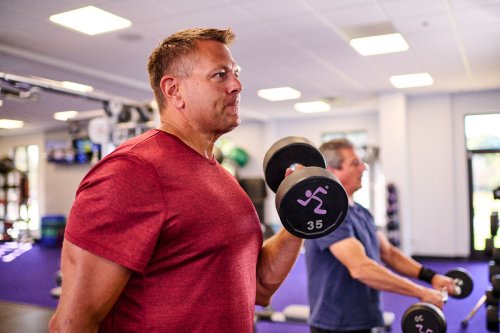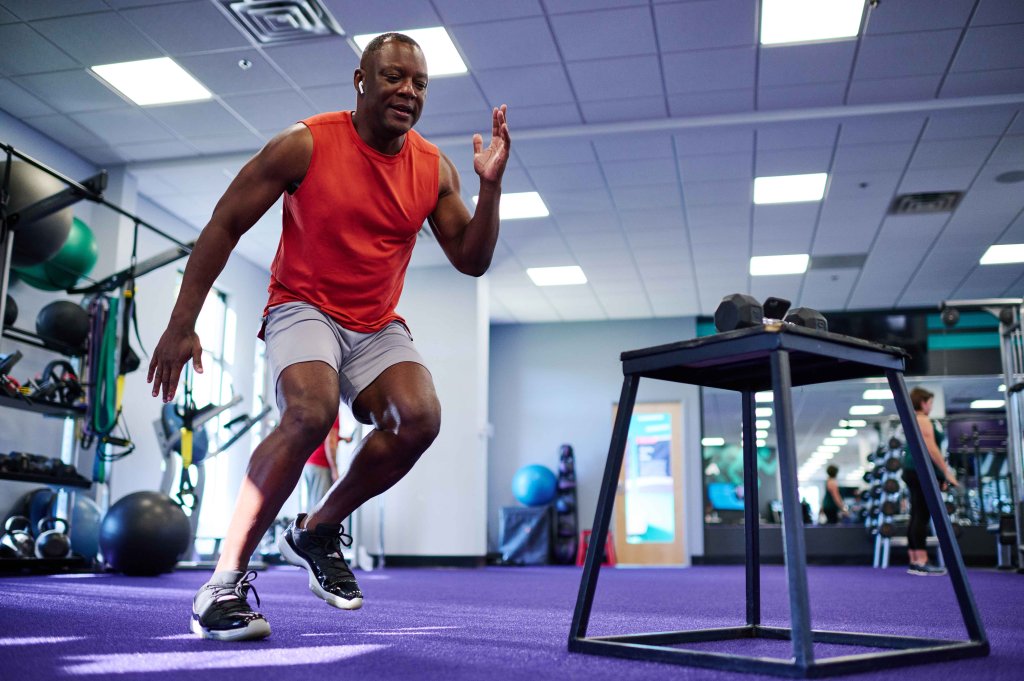You’ve maybe heard the words “aerobic” and “anaerobic” thrown around while at the gym, but do you know what they really are — or how they differ?
These terms are important to know for a well-rounded exercise routine, as they describe how you’re working your body, where you’re taking energy from, and how long the workout is. So, let’s dive into what’s what.
What’s the difference between aerobic and anaerobic exercise?
The short answer: Aerobic exercises are endurance exercises that increase heart and breathing rates over a period of time (for example, going for a 30-minute jog). Anaerobic exercises involve shorter bursts of intense activity (think: sprints). It’s important to get a mix of both aerobic and anaerobic exercises, so let’s dig a little deeper into each so you can better understand how to work them into your fitness routine.
What is aerobic exercise?

Aerobic exercise is any form of cardiovascular conditioning, aka “cardio.” The word “aerobic” means “with oxygen,” so these activities emphasize breathing and stamina. They work large groups of muscles and get your blood pumping. While you’re working out, that blood is oxygenated as it pumps from your heart. What’s nice about aerobic exercise is that you don’t have to max out — it’s just about getting your heart rate up for an extended period of time.
Types of aerobic exercise
You’re likely more familiar with this kind of exercise than you realize! It includes:
- Walking and running
- Cycling
- Swimming
- Dancing
- Hiking
- Recreational sports like basketball, soccer, pickleball, etc.
Benefits of aerobic exercise
As a cardiovascular conditioning exercise, aerobic movement is great for your heart health. If you keep up a good aerobic routine, you can strengthen your heart, fight off heart-related diseases, and prevent buildup in your arteries. And when paired with a suitable diet, aerobic exercise can help you maintain a healthy weight.
You may also feel more upbeat, mentally and physically. Aerobic exercise is linked to lower rates of depression and anxiety, better sleep, and improved self-esteem.
What is anaerobic exercise?

The strength exercises you do on arm and leg days are considered anaerobic exercise. These exercises are short and intense — opposite to aerobic. In fact, “anaerobic” means “without oxygen.” That’s because this kind of exercise doesn’t take energy from the oxygen that’s pumping into the blood like aerobic does. Anaerobic exercises rely on energy stored in the muscles, and unlike aerobic exercises, force you to push it to your limit with each set. That’s why anaerobic exercises are done in short (but intense) bursts.
Types of anaerobic exercises
Anaerobic exercises are all about building muscle, often through resistance training. A few anaerobic activities include:
- High-intensity interval training (HIIT)
- Weightlifting
- Quick sprints
- Box jumping
- Jumping rope
- Pilates
- Yoga
- Battling ropes
- Tabata
Benefits of anaerobic exercise
When you’re lifting weights or doing another form of anaerobic exercise, you’re strengthening your bones, building muscle, maintaining muscle mass, and burning fat. Keeping up with your muscle mass is especially important as you get older, and anaerobic exercise will help prevent age-related muscle loss, osteoporosis, and lack of mobility in the future. Similar to aerobic, anaerobic exercise also has ties to improved self-esteem and mood. And that’s something we can get behind!
Anaerobic exercises are also excellent for weight loss, as they require the body to expend more energy (aka burn more calories). Generally, this leads you to gain more muscle mass and lose more weight.
If you’re measuring progress only using the scale, you’re not getting the full picture. See if your local Anytime Fitness has an Evolt 360 scanner or other body scanning technology that will allow you to monitor your body composition over time.
Overall, it’s important to remember that a balance of aerobic and anaerobic exercise is ideal for keeping your body healthy!
Finding balance between anaerobic and aerobic exercise
Now that you have the rundown on anaerobic and aerobic exercise, how does it all apply to you? Well, it’s all part of a balancing act. The two can work together to keep your body stronger and healthier.
Try to avoid focusing too much on one type of exercise over the other. It is possible to overwork and damage your muscle fibers with anaerobic workouts that are too intense or frequent, or your muscles may lose mass with too little of it. On the other hand, focusing on only aerobic exercises can lead to a plateau in your performance.
The amount of physical activity and intensity levels your body needs depend on several factors, including your goals, age, and current health condition. If you’re a fitness beginner, it might be a good idea to work up to anaerobic exercise over time. Aerobic exercise will boost your cardiovascular endurance and set up a good foundation for anaerobic exercise. Talk to your doctor if you’re wondering what might be best for you.



